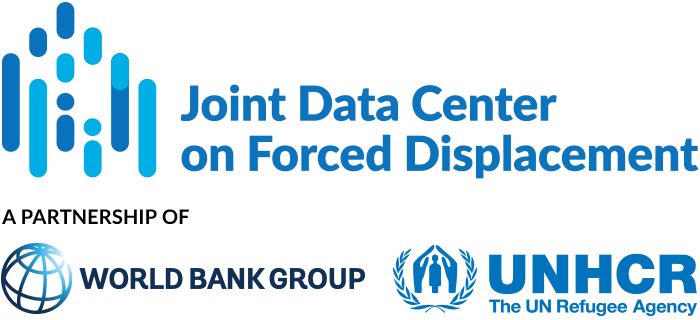This paper estimates the potential savings in humanitarian aid if Sudanese refugees in Chad are able to realize their economic potential. As of February 2024, Chad hosts over 1.3 million refugees, nearly 8 percent of its population, including more than half a million recent arrivals from Sudan. Chad’s legal and policy framework for refugees aims to promote local integration, avoid permanent refugee camps, and encourage self-sufficiency. Refugees have the right to own land, engage in formal employment and commercial activities, move freely, and access banking services. Despite these policies, most refugees reside in camps or “organized sites.”
Data for the analysis comes from the Enquête sur la Consommation des ménages et le Secteur Informel au Tchad (ECOSIT4) survey, which includes a representative sample of refugees and host communities, including Sudanese refugees and host communities in the east of the country.
The authors use the national poverty line of FCFA 684 per refugee per day as a benchmark for the minimum level of consumption needed to ensure a dignified life. They estimate the pre-assistance income earned by poor refugees as the average amount poor households consume net of humanitarian assistance. This represents an inclusion dividend or participation saving that arises when refugees are able to work. The poverty gap, estimated as the difference between the poverty line and refugees’ pre-assistance income, provides an estimate of the humanitarian aid needed for refugees to meet their basic needs. Additionally, the authors estimate the factors influencing refugee income generation, and hence participation savings for Sudanese refugees, using a simple ordinary least squares (OLS) regression.
Main findings:
- The prevalence of poverty among refugees is extremely high, with 80% living below the national poverty line. This incidence rises to 83% when considering pre-assistance consumption. Poverty is also extremely elevated among host communities, with 70% of those within 5 km of a refugee camp (nearby hosts) and within a 15 km radius (distant hosts) living in poverty. This is significantly higher than the poverty rates for rural Chadians (50%) and the average Chadian (42%).
- The poverty gap for refugees is very high. Poor refugees have consumption levels that are, on average, 40% below the national poverty line. Without assistance, this gap would increase to 46% on average and 52% for the poorest refugees.
- Only 12 percent of refugees live above the poverty line. Only 12 percent of Sudanese refugees generate sufficient resources to have pre-assistance consumption levels exceed the poverty line.
- Aid would need to increase more than six-fold to bring all refugees to the poverty line. The international community provides 14% of the cost of basic needs as aid, while 54% is covered by refugees’ self-generated income, facilitated by the Government of Chad allowing refugees to earn incomes. Refugees experience an average shortfall in consumption of 32% relative to the poverty line.
- Chadians also face significant consumption shortfalls. Chadian hosts face a 27% shortfall relative to the poverty line, with 40% unable to meet their minimum caloric intake. Rural Chadians have consumption that falls almost 15 percent short of the poverty line and 19 percent is unable to meet the minimum caloric intake
- Regression analysis identifies several household characteristics significantly correlated with the consumption to poverty line ratio. Larger refugee households experience a higher poverty gap, while higher education levels for the household head are associated with a lower poverty gap and higher income. Households with more dependents tend to have a larger poverty gap, earn less income, and require more aid. Human and social capital, such as connections outside the camp, are linked to reduced need for aid and higher incomes. However, access to land or livestock ownership does not significantly increase income for poor refugees due to low asset levels and returns.
- A descriptive analysis indicates that the dependency ratio, human capital and social capital are the most important factors in reducing aid costs. The dependency ratio is the most important factor in reducing the cost of basic needs aid for Sudanese refugees. Human capital, particularly achieving at least a primary education for the household head, significantly decreases aid costs by over 10%. Social capital is also important in reducing aid costs.
- Economic integration of refugees reduces aid costs. To meet the basic needs of all refugees, US$543 million per annum is required, assuming 1.17 million Sudanese refugees in Chad. The aid requirement reduces to US$437 million due to existing refugees earning incomes. If newly arrived refugees were as integrated as existing ones, the need for subsistence aid would drop to US$252 million. If all Sudanese refugees were fully integrated economically (i.e. on par with hosts), the need for assistance could potentially drop to US$89 million.
The authors argue that the most effective way to future-proof the refugee response is to enhance the ability of refugees to earn incomes. The authors recommend (i) increasing asset ownership among refugees; (ii) improving the overall economic environment for both hosts and refugees; and (iii) allowing refugees to move to areas with the greatest economic opportunities.
To finance this approach, the authors propose a system where international agencies initially finance the burden of assistance to refugees, while the host government grants refugees the right to work. As refugees begin to earn incomes over time, the need for consumption support decreases, allowing aid to be redirected. These savings should be invested in host communities to address any short-term frictions and to accelerate the restoration of refugees’ productive potential, laying the foundation for even greater future savings. In the medium term, as the economy adapts and frictions dissipate, and as refugees become more financially autonomous, international agencies can gradually reduce their financial support, aligning it with the remaining needs.


